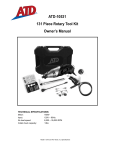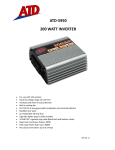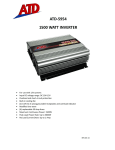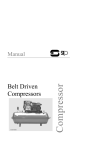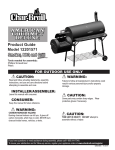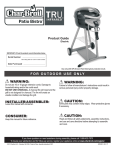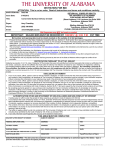Download ATD Tools ATD?10525 Specifications
Transcript
ATD‐10525 12V CORDLESS LITHIUM ION DRILL & DRIVER COMBO KIT Instruction Manual KNOW YOUR PRODUCT (DRILL) 1. Keyless chuck 2. Torque adjustment collar 3. Speed selector 4. Forward/reverse selector 5. Battery 6. Battery release buttons 7. Variable speed switch 8. LED light 9. Quick Battery Charger Drill Specifications: Motor: 12V Charge time: 90 minutes No load speed: 0 – 350/min, 0 – 1150/min Chuck: 10mm Keyless Torque: 11 ft. lbs. Battery: 1.3Ah Lithium Ion Weight with 1 battery: 1.05kg KNOW YOUR PRODUCT (DRIVER) 1. Quick Release chuck 2. Torque adjustment collar 3. Speed selector 4. Forward/reverse selector 5. Battery 6. Battery release buttons 7. Variable speed switch 8. LED light 9. Quick Battery Charger Driver Specifications: Motor: 12V Charge time: 90 minutes No load speed: 0 – 350/min, 0 – 1150/min Chuck: Quick Release Chuck Torque: 11 ft. lbs. Battery: 1.3Ah Lithium Ion THIS SECTION CONTAINS IMPORTANT SAFETY AND OPERATING INSTRUCTIONS FOR YOUR BATTERY CHARGER. Danger! If the battery pack case is cracked or damaged, do not insert into charger. There is a danger of electric shock or electrocution. Warning! Do not allow any liquid to get inside charger. Electric shock may result. To facilitate cooling of the battery pack after use, avoid placing the charger or battery pack in a warm environment such as in a metal shed, or an un‐insulated trailer. OTHER PRECAUTIONS: • Before using the charger, read all instructions and cautionary markings on charger, battery pack and product using the battery pack. • This charger is not intended for any uses other than charging rechargeable batteries. Any other use may result in risk of fire, electric shock or electrocution. • Do not place any object on top of the charger or place the charger on a soft surface that may result in excessive internal heat. Place the charger in a position away from any heat source. • To reduce risk of damage to the electric plug and cord, pull by the plug rather than the cord when disconnecting the charger. • Make sure cord is located so that it will not be stepped on, tripped over, or otherwise subjected to damage or stress. • An extension cord should not be used unless absolutely necessary. Use of an improper extension cord could result in the risk of fire, electric shock or electrocution. • Do not operate charger if it has received a sharp blow, been dropped or otherwise damaged in any way. Have it checked by an electrician or power tool repairer. • Do not disassemble charger. Take it to an electrician or power tool repairer when service or repair is required. Incorrect reassembling may result in a risk of electric shock, electrocution or fire. • To reduce risk of electric shock, unplug charger from the outlet before attempting any cleaning. Removing the battery pack will not reduce this risk. • Never attempt to connect 2 chargers together. • DO NOT store or use the tool and battery pack in locations where the temperature may reach or exceed 104º F (40ºC) (such as outside sheds or metal buildings in summer). • The charger is designed to operate on standard household electrical power (110 volts AC). • Do not attempt to use it with any other voltage! • The battery pack is not fully charged out of the carton. First read the safety instructions and then follow the charging notes and procedures. • The longest life and best performance can be obtained if the battery pack is charged when the air temperature is between 64 ‐ 75º F (18 ‐ 24ºC). Do not charge the battery pack in an air temperature below 50º F (10ºC) or above 104º F (40ºC). This is important and will prevent damage to the battery pack. • Do not incinerate the battery pack even if it is seriously damaged or is completely worn out. The battery can explode in a fire. • Never attempt to open the battery pack for any reason. If the plastic housing of the battery pack breaks or cracks, immediately discontinue use and do not recharge. Warning! Read all safety warnings and all instructions. Failure to follow the warnings and instructions may result in electric shock, fire and/or serious injury. Save all warnings and instructions for future reference. The term "power tool" in all of the warnings refers to your mains‐operated (corded) power tool or battery‐operated (cordless) power tool. 1) Work area safety a) Keep work area clean and well lit. Cluttered and dark areas invite accidents. b) Do not operate power tools in explosive atmospheres, such as in the presence of flammable liquids, gases or dust. Power tools create sparks which may ignite the dust or fumes. c) Keep children and bystanders away while operating a power tool. Distractions can cause you to lose control. 2) Electrical safety a) Power tool plugs must match the outlet. Never modify the plug in any way. Do not use any adapter plugs with earthed (grounded) power tools. Unmodified plugs and matching outlets will reduce risk of electric shock b) Avoid body contact with earthed or grounded surfaces such as pipes, radiators, ranges and refrigerators. There is an increased risk of electric shock if your body is earthed or grounded. c) Do not expose power tools to rain or wet conditions. Water entering a power tool will increase the risk of electric shock. d) Do not abuse the cord. Never use the cord for carrying, pulling or unplugging the power tool. Keep cord away from heat, oil, sharp edges or moving parts. Damaged or entangled cords increase the risk of electric shock. e) When operating a power tool outdoors, use an extension cord suitable for outdoor use. Use of a cord suitable for outdoor use reduces the risk of electric shock. 3) Personal safety a) Stay alert, watch what you are doing and use common sense when operating a power tool. Do not use a power tool while you are tired or under the influence of drugs, alcohol or medication. A moment of inattention while operating power tools may result in serious personal injury. b) Use personal protective equipment. Always wear eye protection. Protective equipment such as dust mask, non‐skid safety shoes, hard hat, or hearing protection used for appropriate conditions will reduce personal injuries. c) Prevent unintentional starting. Ensure the switch is in the off‐position before connecting to power source and/or battery pack, picking up or carrying the tool. Carrying power tools with your finger on the switch or energizing power tools that have the switch on invites accidents. d) Remove any adjusting key or wrench before turning the power tool on. A wrench or a key left attached to a rotating part of the power tool may result in personal injury. e) Do not overreach. Keep proper footing and balance at all times. This enables better control of the power tool in unexpected situations. f) Dress properly. Do not wear loose clothing or jewelry. Keep your hair, clothing and gloves away from moving parts. Loose clothes, jewelry or long hair can be caught in moving parts. g) If devices are provided for the connection of dust extraction and collection facilities, ensure these are connected and properly used. Use of these devices can reduce dust‐related hazards. 4) Power tool use and care a) Do not force the power tool. Use the correct power tool for your application. The correct power tool will do the job better and safer at the rate for which it was designed. b) Do not use the power tool if the switch does not turn it on and off. Any power tool that cannot be controlled with the switch is dangerous and must be repaired. c) Disconnect the plug from the power source and/or the battery pack from the power tool before making any adjustments, changing accessories, or storing power tools. Such preventive safety measures reduce the risk of starting the power tool accidentally. d) Store idle power tools out of the reach of children and do not allow persons unfamiliar with the power tool or these instructions to operate the power tool. Power tools are dangerous in the hands of untrained users. e) Maintain power tools. Check for misalignment or binding of moving parts, breakage of parts and any other condition that may affect the power tools operation. If damaged, have the power tool repaired before use. Many accidents are caused by poorly maintained power tools. f) Keep cutting tools sharp and clean. Properly maintained cutting tools with sharp cutting edges are less likely to bind and are easier to control. g) Use the power tool, accessories and tool bits etc. in accordance with these instructions and in the manner intended for the particular type of power tool, taking into account the working conditions and the work to be performed. h) Use of the power tool for operations different from those intended could result in a hazardous situation. 5) Service a) Have your power tool serviced by a qualified repair person using only identical replacement parts. This will ensure that the safety of the power tool is maintained. b) If the supply cord is damaged, it must be replaced by the manufacturer, its service agent or similarly qualified persons in order to avoid a hazard. Over Charging Protection This feature ensures that the battery is never overcharged. When the battery has reached its full charge capacity the charger will shut off protecting the internal components of the battery from being damaged. Over Discharge Protection An internal component of the battery pack is an over discharge protector. This feature will stop the battery from discharging beyond the recommended lowest safety voltage. Over Heat Protection The battery has an internal Thermistor cut off sensor which will cease the charging cycle if the battery becomes hot during the charging process. This Thermistor sensor will also stop the battery from operating should the battery become too hot during the operation of the tool. This can happen when the tool is overloaded or being used for extended periods of time. Up to 30 min in cooling time may be required depending on ambient temperature and operation being performed. Over Current Protection Should the battery be overloaded and the maximum current draw be exceeded the battery will temporarily stop working to protect the internal components. The battery will resume to normal operation once the excessive current draw has returned to normal safe level. This may take a few seconds. Short Circuit Protection If the battery pack was to short circuit the short circuit protector would immediately stop the battery pack from operating. This will ensure that no further internal components of the battery or the tools are damaged. The drill has been shipped in a low charge condition, and requires charging prior to use. • Plug the charger (9) into a 120V power outlet. Ensure that the charger (9) is on a flat is on a flat surface. • Insert the battery (5) into the charger (9). The recess of the battery terminals will have a firm connection. • Upon proper contact the red and green light will illuminate on the charger (9). • The battery (5) will take 90 minutes to charge. Charging starts automatically. Remove the battery (5) from the charger after 90 minutes. • NOTE: If light on the charger (9) fails to come on: • Check the charging adaptor (9) is securely plugged into the wall outlet and is switched on. • Check the battery (5) is firmly seated onto the charger (9). Initial Charge • When the unit is on charge the red and green light will be on display. • The green light will appear only when the battery is fully charged. • Charge your battery for 90 minutes then use it until it runs down and only slowly operates. • Repeat this charge and discharge process approximately 4‐5 times, this will ensure that the battery is performing to its highest capacity. Important Charging Notes • The charger and battery (5) may become warm to touch while charging. This is a normal condition, and does not indicate a problem. • Use the charger at normal room temperature whenever possible. To prevent overheating, do not cover the charger and do not charge the battery (5) in direct sunlight or near heat sources. If the battery (5) does not charge properly: 1. Check current at power outlet by plugging in a lamp or other appliance. 2. If charging problems persist, have the complete drill checked by an electrician or a power tool repairer. NOTE: If battery is low or dead and displays green charged LED, refer to Thermal voltage protection note below. Cooling may be required. Thermal voltage protection indication In the event that the thermal or voltage protection circuit has been activated the battery will cease to operate. This can happen when the tool has been used for extended periods or worked hard with large drill bits or accessories. If you place the battery on the charger the LED lights will give you the appearance that the battery is fully charged. Leave the battery on the charger to charge for 90 minutes. The battery may take the full 90 minutes to charge as the battery may need to cool down or the protection circuit to be reset. This will then allow the charger to begin charging the battery and resume normal operation. Always switch off the drill before insertion or removal of the battery (5). Installing the Battery • Holding the drill upright and picking up the battery (5) in your opposite hand. Place two fingers over the battery release buttons (6) and insert the battery (5) until it clicks into place (See Fig. 2). • Do not use excessive force when inserting the battery (5). If the battery (5) does not slide in easily, it is not being inserted correctly. It is also possible that there could be damage to the battery (5), battery terminals or the drill. Removing the Battery Depress both the battery release buttons (6) and gently pull the battery (5) out of the drill. Battery The length of service from each charging cycle will depend on the type of work you are doing. The battery (5) in this drill have been designed to provide maximum trouble free life. To obtain the longest possible battery life, we suggest the following: • Store and charge your battery (5) in a cool area. Temperatures above or below normal room temperature will shorten battery life. • Never store batteries in a discharged condition. Recharge them immediately after they are discharged. • All batteries gradually lose their charge. The higher the temperature the quicker they lose their charge. If you store your drill for long periods of time without using it, recharge the batteries every month or two. This practice will prolong battery life. Variable Speed Switch Turn the drill ON by depressing the variable speed switch (7) . To turn the drill OFF release the variable speed switch (7) (See Fig. 3). The speed can be varied from 0 to maximum in either gear, depending on the pressure applied to the variable speed switch (8). This way you can select the best possible speed for the job required. Changing the Direction of Rotation The direction of rotation can be changed with the forward/reverse selector (4). This is located above the variable speed switch (7) (see Fig. 4). To select the forward drilling position, push the forward/reverse selector (4) hard left. To select the reverse drilling position, push the forward/reverse selector (4) hard right. The variable speed switch (7) can be locked off by pushing the forward/reverse selector (4) into the middle of both the forward and reverse positions. Do not change the direction of rotation while the keyless chuck (1) is in motion. Speed Control The drill has a 2 speed gearbox. The speed selector (3) is located on the top of the drill (see Fig. 5). First gear has a range of 0‐350/min. Second gear has a range of 0‐1150/min. Torque Settings (Tightening power of your drill) When using your drill for various driving applications, it becomes necessary to increase and decrease the power and torque in order to prevent the possibility of damaging screw heads, threads, work pieces, etc. In general, power and torque should correspond to the difficulty of the screw to be driven. If torque is too high, the screws can be damaged or broken. To Adjust Torque • Locate the arrow on the front of the drill housing (see Fig. 6). • Identify the torque settings and 1 drill setting on the torque adjustment collar (2). • Rotate the torque adjustment collar (2) to the desired setting, aligning the required number on the torque adjustment collar (2) with the arrow on the drill housing. • To increase or decrease torque, rotate the torque adjustment collar (2). The lower the number, the lower the torque setting. The higher the number, the higher the torque setting. Always check that the correct torque is selected by practicing on scrap material prior to carrying out a job. The torque setting required to drive screws will differ with different materials. Start with the torque setting on the number you think is appropriate (Eg: 4) and simply increase the torque adjustment collar to a higher number if the screw head is not sitting flush with your workpiece. Remove the screw after adjusting and re‐drive the screw back into the workpiece until the correct torque adjustment leaves the screw head flush with your workpiece. Keyless Chuck A keyless chuck (1) is included on your drill to allow for easy installation and removal of bits/accessories. To open and close the keyless chuck (1), rotate the chuck body with your other hand (see Fig. 7). The arrows on the chuck indicate in which direction to rotate the chuck body in order to GRIP (tighten) or RELEASE (unlock) the drill bit. Warning! Do not hold the chuck body with one hand and use power of the drill to tighten or loosen the chuck jaws. The chuck body could slip and your hand could come in contact with a rotating accessory. This could cause an accident resulting in personal injury. Installing Drill or Driver Bits • Remove the battery (5) from the drill. • Open or close the keyless chuck (1) to a point where the opening is slightly larger than the drill or driver bit you intend to use. • Insert the drill or driver bit into the keyless chuck (1), ensuring the end of the drill or driver bit does not touch the screw inside the keyless chuck (1). • Tighten the keyless chuck (1) onto drill or driver bit as above (See Fig. 8). Removing Drill/Driver Bits • Remove the battery (5) from the drill. • Loosen the keyless chuck (1) as described previously. • Remove the drill or driver bit from the keyless chuck (1). Note: Do not handle drill bits without gloves as drill bits and other accessories are sharp or can be hot after use, this can cause personal injury. General Hints for Drilling in all Materials • Always use sharp drill bits. • Mark the place where you would like the hole to be drilled. • Commence with a slow speed to start the hole (see section "Speed Control" for directions on how to do this). • Reduce your pressure on the drill when the drill bit is about to break through the material. Metal Drilling • Support thin material with a piece of scrap wood. • Use a center punch to mark the position of the hole. • If drilling a large hole, use a small size drill bit first to establish a pilot hole then use the required large size drill bit. • Use only HSS (high speed steel) drill bits or those recommended for metal use. • When drilling into iron or steel, use a cooling lubricant such as thin oil. With aluminum, use turpentine or paraffin. With brass, copper and cast iron, use no lubricant but withdraw the drill regularly to assist cooling. Wood Drilling • Mark the place where you want to drill with a punch or a nail. • To avoid splintering on breakthrough, either clamp a piece of scrap wood to the back of your workpiece or continue the hole from the back of the wood when the drill bit first breaks through. LED Light • The drill has 1 LED Light (8) built into the unit. The LED light is located above the variable speed switch. • The LED light (8) turns on automatically when you depress the variable speed switch (7). • The LED light illuminates dark areas in tight corners to assist with drilling and screw driving. This helps achieve a more accurate result in your workpiece. • • • • When not in use, the drill should be stored in a dry, frost free location, out of reach of children. Keep ventilation slots of the drill clean at all times and prevent any foreign matter from entering. If the housing of the drill requires cleaning, do not use solvents but a moist soft cloth only. Blow out the ventilation slots with compressed air periodically. Note: ATD Tools, Inc will not be responsible for any damage or injuries caused by repair of the drill by an unauthorized person or by mishandling of the drill. Limited spare parts are available subject to availability. Please contact your local ATD distributor to order the required spare parts. PRT10525‐01 ‐ REPLACEMENT DRILL W/O BATTERY PRT10525‐02 ‐ REPLACEMENT DRIVER W/O BATTERY PRT10525‐03 ‐ REPLACEMENT LI‐ION BATTERY PRT10525‐04 ‐ REPLACEMENT FAST CHARGER Power tools that are no longer usable should not be disposed of with household waste but in an environmentally friendly way. Please recycle where facilities exist. Check with your local council authority for recycling advice. Recycling packaging reduces the need for landfill and raw materials. Reuse of recycled material decreases pollution in the environment. Please recycle packaging where facilities exist. Check with your local council authority for recycling advice. CONTENTS: 1 x 12V Cordless Lithium Ion Drill 1 x 12V Cordless Lithium Ion Driver 1 x Quick Batter Charger 2 x Lithium Ion Battery 1 x Soft bag 1 x Instruction manual WARRANTY 1 YEAR REPLACEMENT WARRANTY THIS WARRANTY AND CONFIRMED RECEIPT(S) SHOULD BE RETAINED BY THE CUSTOMER AT ALL TIMES The warranty is only made available by returning the product to the point of sale. PURCHASED FROM:________________________________________________ DATE PURCHASED: ________________________________________________ INVOICE/RECIEPT NUMBER:_________________________________________ Your ATD10525 is warranted for a period of 12 months from the original date of purchase. This warranty is valid for defects in workmanship or materials only, and is handled at the point of sale. The warranty given on this tool is against defects in workmanship and materials only. Any misuse, abuse or accidental damage is not covered by warranty. The following actions will also result in the warranty being void: • If the tool has been operated on a supply voltage other than that specified on the tool. • If the tool shows signs of damage or defects caused by or resulting from abuse, accidents or alterations. • If the tool is disassembled or tampered with in any way. Note: Warranty excludes consumable parts such as carbon brushes, drill and driver bits and chucks. [Affix receipt or invoice here for safe keeping]












